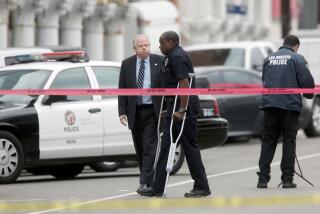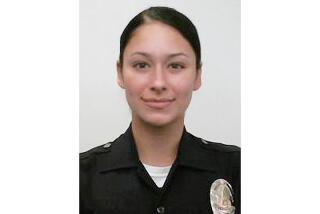Madison police officer won’t be charged in shooting death of unarmed man
- Share via
A white police officer used lawful force and won’t face criminal charges for fatally shooting an unarmed black man who was acting strangely and had assaulted two people in Madison, Wis., prosecutors have determined.
Dane County Dist. Atty. Ismael Ozanne said Tuesday that Officer Matt Kenny, 45, acted within his authority when he fired seven shots at Tony Robinson, 19. Ozanne frequently wiped sweat from his brow as he detailed the events of March 6.
“I conclude that this tragic and unfortunate death was the result of a lawful use of police force and no charges should be brought,” he said at a news conference.
Robinson’s death, one in a string of deadly confrontations between police and African Americans across the nation, led to large but peaceful protests in Madison in recent weeks. Ozanne, who is biracial, called on protesters to peacefully pursue change.
Before announcing his decision not to charge Kenny, Ozanne emphasized his own heritage.
“I am a person of color from a biracial marriage,” he said. “I am the son of a black woman born in Alabama.” He said his mother was active in the civil rights struggle in the South.
“My decision will not bring Tony Robinson back. My decision will not end the racial disparities that exist. My decision is not based on emotions,” said Ozanne, who publicly apologized to Robinson’s family for their loss.
Relatives of Robinson told reporters that they support peaceful protests about the decision not to charge the officer.
“I wear a sweater because this is the only comfort I have left,” Sharon Irwin, Robinson’s grandmother, said at a separate news conference. “This is politics and not justice.”
Robinson’s mother, Andrea Irwin, said she was not surprised by the decision, but said the investigation should have been more thorough. “They could have done a lot. What they didn’t do was give my son any respect,” she said.
On Tuesday evening, about 100 people joined a peaceful demonstration and marched through Madison, the state capital. They sang civil rights-era gospel hymns and carried a banner that read, “Black lives matter.”
The Wisconsin Department of Justice investigated the March 6 shooting under a state law that requires outside agencies to lead inquiries into officer-involved deaths. Ozanne outlined those findings.
Kenny, a 13-year-veteran of the department, was responding to calls that Robinson was running in and out of traffic and had assaulted two people, the prosecutor said, adding that Robinson had used illegal drugs earlier.
Kenny reported that when he entered the apartment building, he heard sounds of a disturbance upstairs. He believed “Robinson was the person he was looking for and was possibly assaulting someone else,” the prosecutor said.
Ozanne said that as Kenny climbed the stairs he confronted Robinson, who struck the officer with his fist. Kenny reported that he was rocked back and was losing balance as Robinson continued to move toward him, still swinging. The officer was afraid that he would be struck again and that his firearm would be taken to shoot him or another person, Ozanne said.
Kenny fired seven shots in three seconds, all of which hit Robinson, Ozanne said.
The officer then radioed for an ambulance and administered aid to Robinson until the paramedics arrived. Robinson died at a hospital, police said.
On Tuesday, television broadcast images of religious leaders singing near the house where Robinson was shot, with one pastor calling for justice.
The Police Department said in a statement Sunday that it had been preparing for Ozanne’s announcement for weeks, efforts that included holding meetings with community leaders.
“It is our hope — that working together — Madison can come through these challenging days ahead without violence or property damage,” the statement read.
Kenny has been on paid administrative leave since the shooting.
According to local news reports, Kenny had earned 46 accolades, mostly from supervisors who commended him for saving lives and used him to train other officers in first aid and firearms. He earned a Medal of Valor after he shot and killed 48-year-old Ronald Brandon in 2007. Brandon had reportedly waved a realistic-looking pellet gun at officers in what police described as a “suicide-by-cop” incident.
Kenny’s personnel file also includes one reprimand for leaving his gun in a public restroom in 2007.
Robinson graduated from Sun Prairie High School last year. The son of a white mother and black father, he identified himself as an African American. He pleaded guilty in December in connection with an armed robbery and was sentenced to probation. A pre-sentencing report described Robinson as an impulsive risk-taker who faced a choice between the gang world and a middle-class lifestyle, according to published reports.
Police Chief Michael C. Koval has described Kenny, who also served as a U.S. Coast Guard medic, as a consummate professional.
Koval, who holds journalism and law degrees, served as an FBI agent and Madison police recruiting officer before becoming chief of the department in 2014. He won accolades for how he handled the aftermath of the shooting, including going to pray with Robinson’s grandmother in the family’s driveway.
At a news conference after the announcement, Koval said he sent “heartfelt condolences” to Robinson’s family and said police could not singlehandedly deal with joblessness and inequalities in the educational system that have helped drive some recent protests across the nation.
Koval also took to his blog Tuesday with a lengthy post calling for peace.
“In the aftermath of this decision, our city finds itself at a crossroad. How will we -- as community -- choose to respond?” he wrote. “Will the narratives portrayed elsewhere become our ‘moment’ where Madison becomes another provocative story line marred with senseless acts of disorder which only serve to disrespect the rights and property of others?”
Koval took the unusual step of spelling out what protesting activities were protected and what could get demonstrators arrested, warning that some criminal arrests could result in fingerprinting, DNA swabs and unintended consequences.
“Frankly, if left to prospective unscrupulous landlords or employers, abuse of [court records] can be a mechanism for discrimination,” Koval wrote. “I would strongly urge complete avoidance of getting a RAP sheet (a record of arrests and/or prosecutions)!”
In another police shooting case, this one in Cleveland, Cuyahoga County Sheriff Clifford Pinkney said Tuesday that a “majority” of his department’s investigation into the November death of Tamir Rice, a 12-year-old black boy, was finished. He did not offer a deadline for its completion.
“My department has conducted a fair, thorough and impartial investigation,” Pinkney said. “We’ve pored over thousands of documents and conducted numerous interviews.”
Pinkney’s department began its work in January, when Cleveland police and city officials agreed to hand the investigation to the sheriff’s office. But the lack of answers from Pinkney prompted one person to shout, “Six months! It’s been six months!” as the news conference ended.
Rice’s death, along with the killings of Michael Brown in Ferguson, Mo., and Eric Garner in New York’s Staten Island, helped stoke a national conversation about race and policing. But the investigation into Rice’s death has taken considerably longer than those of Garner and Brown.
Times staff writer Kurtis Lee contributed to this report.
Follow @latimesmuskal for national news.
More to Read
Sign up for Essential California
The most important California stories and recommendations in your inbox every morning.
You may occasionally receive promotional content from the Los Angeles Times.















